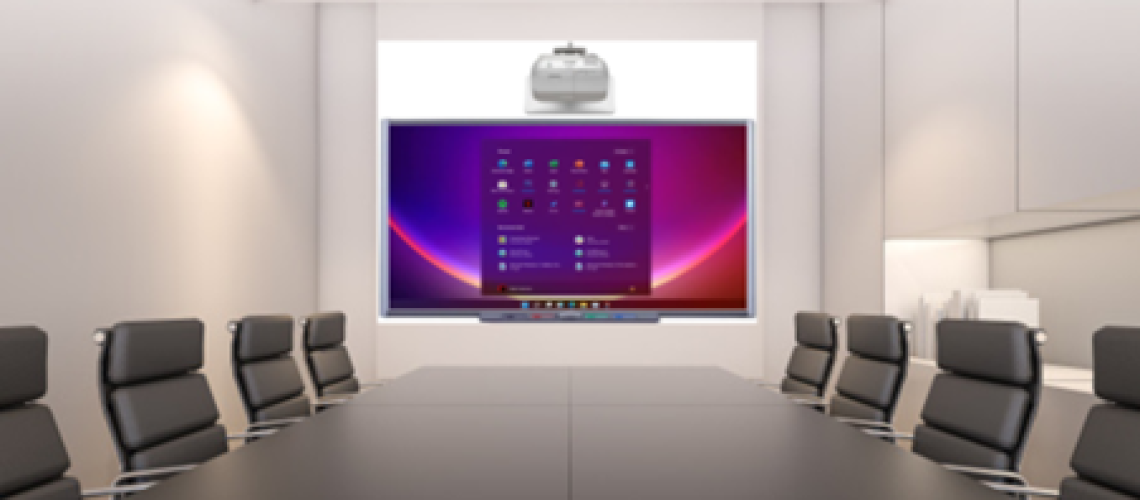Are you a business owner who wants to take your business to the next level? If so, you need the right equipment for your office or workspace. Investing in projectors can help enhance your work environment and provide you with many benefits.
In this guide, we’ll discuss the importance of projectors and what types are available to help boost your business.
Projectors are one of the most versatile ways to visually promote your business. Whether you’re in need of new conference room technology or plan on hosting in-store events or presentations, projectors provide a great solution and way to capture your audience’s attention.
The first step in the selection process is determining how your projector will be used. Will you be using it mainly indoors or outdoors; will it be primarily used to watch videos, or will it be used to aid in presentations? Once you’ve answered these questions, you can narrow down the type of projector you need by deciding what features and capabilities are important for your particular application. Here’s a quick guide on choosing the right projector for your business:
- Determining brightness: Brightness is measured in lumens and generally the higher, the better — consider 1500 lumens to be the minimum for a good image. Depending on the environment where it’s being used, projectors vary from 2000-5000 lumens.
- Resolution: This refers to how many pixels are displayed on a given area and higher resolutions exhibit more detail so people have less trouble making out small text or graphics from farther away. Popular resolutions include XGA (1024 x 768) or WXGA (1280 x 800). For larger rooms using larger images, look into HDTV formats like 1080p (1920×1080) resolution as they provide more pixels per square inch compared to XGA and WXGA formats.
- Type of Lamp: Projector lamps come in several types — including long-life models with extremely low wattage power consumption that last up to 20,000 hours with zero color decay — so decide which option meets both performance requirements as well as budget limitations before buying a model that doesn’t fulfill all criteria desired by your business needs.
4 .Portability: Think about portability when looking at projectors since many newer models now have lower weight and smaller sizes that make them ideal for those who travel frequently for business purposes if portability is required for their presentation needs.
5 .Connectivity & Networking Options: Depending on what type of presentations you’ll be making and if any digital transmissions like 3d signals through blu ray players are anticipated streaming options/ digital media can also be viewed over wifi/internet connection which allow access via mobile device platforms making setup fast and easy. Additionally most display devices come included with HDMI, VGA ports etc so look at this closely when making an ultimate decision.
Importance of projectors for business
Projectors have become an essential tool for business owners as they offer efficient collaboration solutions and enhance communication. Not only are projectors versatile, but they also enable businesses to showcase their products, events and more in a professional, engaging way. With the help of a projector, companies can easily share PowerPoints and visual presentations with clients or staff.
Moreover, projectors come in a range of sizes and options to suit any workspace and budget.
The importance of projectors for business cannot be underestimated as they are equipped to revolutionise teamwork in the office environment by creating an immersive experience that involves every employee simultaneously. As companies aim to produce better results with fewer resources, projectors can increase productivity by providing quick access to information that is called up on-screen quickly and accurately.
Furthermore, when used for company training sessions or lectures on new products or techniques; having the ability to display large-scale visuals instead of relying on traditional whiteboards is invaluable when it comes to engaging everyone in the room. Projector quality also plays an important role as quality visuals offer better attention retention from viewers compared to basic visuals from other presentation formats. With its portability and affordability over other communication solutions like video conferencing systems or monitor walls; using a projector is often much more economical for businesses with tight budgets yet requiring top-notch presentations for their clients or staff members.

Factors to Consider When Choosing a Projector
When choosing a projector for a business or office, many factors should be considered and compared to find the best solution for the space and environment. Here are some key points to think about when making this important decision.
Size: The size of the projector is determined by the distance from the screen, as well as preferred image size and resolution. Longer distances from the screen will require a brighter projector with a greater lumen output. For rooms with lights that are not able to be dimmed, look for projectors that have high lumen ratings.
Resolution: Resolution is determined by Pixels per Inch (PPI) or Pixels per Meter (PPM). Higher resolutions are ideal for smaller projection sizes while lower resolutions are best used at larger distances from the screen. Look for projectors with smoother images and more natural color representation.
Connectivity: Most modern projectors come equipped with wireless as well as physical connections such as HDMI/VGA ports, built-in speakers, microphone inputs and more. Some models offer built-in media player functionality which eliminates needing an HDMI cable to connect your device. It is essential to check what type of connections are needed before purchase.
Lumen Output: Lumen output measures how brightly your projector can display an image in your desired space and is crucial for any location where controlled lighting cannot be achieved or where one wishes to project onto a large projection surface such as conference rooms or larger areas of displays need multiple people viewing at once. It’s widely accepted that a high ratio between brightness (measured in ANSI Lumen) and contrast (measured in black level) results in better image detail representation on projections surfaces ranging from whiteboards to cinema screens.
Throw Ratio: The throw ratio determines how far away you can place your projector from the projection surface it’s displaying on; usually expressed in feet or meters away per foot wide of projected image canvas size on the surface it’s projecting onto.. Shorter throw ratios allow users with smaller spaces they need their image produced pay closer attention when selecting their products
3D Capability: More advanced projectors may also include 3D capability via active-shutter glasses which allow viewing content in three dimensions either directly on 3D Blu Ray players or over other media sources such HDTV’s & Computers equipped with 3D output.
Brightness and Contrast
The brightness and contrast of a projector refer to how well its image appears on the screen or wall. Brightness is measured in lumens, which indicates how visible the image will be in a variety of different light settings, including bright light sources and darkened meeting rooms. Contrast is expressed as a ratio between white and black, indicating how much detail can be seen from the brightest whites throughout to the deepest blacks.
Most business projectors have an output of 2000-3000 lumens with contrast ratios between 1500:1 and 3000:1. Generally speaking, it’s best to look for projectors with higher lumen output and higher contrast ratio for increased visibility and overall excellent performance.

Resolution
Resolution is a major factor to consider when choosing the right projector for your office or workspace. As the pixel count of the resolution goes up, so does its sharpness, brightness, and clarity. Higher resolution also means better color accuracy, allowing you to display fine details with more precision.
Common resolutions for projectors include XGA (1024 x 768 pixels), HD (1920 x 1080 pixels) and Ultra HD (3840 x 2160 pixels). What’s more, the higher the native resolution capability of a projector is, the better it is able to handle computer signals such as those coming from high-resolution sources like Blu-ray players and game consoles.
However, bear in mind that not all presentation material can take advantage of a higher resolution projector; if your content consists mostly of standard PowerPoint slideshows and well-compressed video clips then you may be better off without investing in an ultra-high resolution projector.
Connectivity
When you’re purchasing a projector for your office or workspace, the connectivity options provided by the model should always be considered. After all, the ability to attach a laptop or PC is an essential feature of any projector, so it’s important to make sure that the unit you choose has adequate ports for connectivity. Being able to connect multiple storage devices can also have numerous advantages, making it possible for one person to share their material with multiple users at once. Connecting a location-based display unit and/or remote connection can simplify sharing data even further.
The types of ports available on a given projector model vary, but HDMI and USB ports tend to be standard offerings across most models. Some projectors may also come with wireless components such as Wi-Fi or Bluetooth, allowing you maximum flexibility when setting up and controlling your display device. It’s worth noting that some of these features may not come preinstalled on your projector but can be added via an adapter or cable.
Size and Portability
When choosing a projector for your office or workspace, one of the primary considerations should be size and portability. If you plan to move your projector between multiple locations, then a model with easy portability is essential. Some of the most popular portable options include LED projectors, which are small, lightweight, and can often run on battery power. For larger spaces where you will rarely need to move the projector, it’s usually better to invest in a larger model with higher projection brightness and resolution.
In terms of size and weight, there are various trade-offs that you need to consider when making your choice. Do not buy any model that is too big for your space or too heavy for you to mange due logistics concerns — check whether dimensions and weight are clearly stated in the product description before buying. Additionally, if space is limited, ensure that there is enough ventilation around the unit as projected images can become distorted when it overheats from lack of air circulation.
Lamp Life and Maintenance
One of the most important factors in projector maintenance and upkeep is lamp life. Depending on manufacturer, models vary in the amount of hours their lamps can be used before they need to be replaced. Average report is between 5,000-10,000 hours, however many ultra-high devices now offer around 15,000 hours of use. To get the most out of your device’s lamp life it’s recommended to switch it off when not in use and reduce contrast and brightness levels. Many projectors are equipped with ‘eco’ or ‘smart’ modes which work to optimise power consumption and reduce wear on bulbs over time.
Another important aspect of projector upkeep is general maintenance such as periodic dusting and cleaning locks and vents. This helps keep internal components like fans working optimally for maximum performance onscreen. Keeping traditional bulbs clean requires simple cleaning wipes at regular intervals while selecting self-cleaning models will ensure your device remains clog free with minimal intervention from you as a user. There are many products available online and through specialist stores that help maintain projection equipment such as air filters to protect machines from against external particles like smoke or dust – helping prolong the lifespan further without any effort from the user whatsoever!

Conclusion
After carefully examining the different projector options, it is important to think about what kind of product will best meet your needs. All of the projectors discussed here are designed to fit certain types of spaces and usage styles. Think about whether you need a smaller, more portable model or a larger one with better picture quality. Then consider your budget and how quickly you may want to upgrade in the future.
Ultimately, there is no one-size-fits-all solution for choosing the right projector for your workspace. Research and consideration should be taken before making an informed decision that meets all of your requirements.
The most important thing is to understand how these devices work, evaluate your needs, and find the product that fits both perfectly. With careful research into features such as brightness, contrast, resolution and portability, as well as past reviews from other customers who have purchased similar models in the past, you can find the perfect projector for your office or workspace.
FAQs
What is the best projector for business?
The best projector for business will depend on factors such as brightness, resolution, connectivity options, and portability. Look for projectors with high brightness levels and good color accuracy, such as the Epson Pro EX9220 or Optoma EH412ST.
What is the benefit of projector in office?
Projectors can offer several benefits in the office, such as larger display sizes, better collaboration during meetings, and more engaging presentations.
What are projectors used for in business?
Projectors are commonly used in business for presentations, video conferences, and training sessions.
What is a projector in an office?
A projector in an office is a device used to display images or videos on a larger screen, usually for presentations or meetings.
Do offices still use projectors?
Yes, many offices still use projectors as they can offer larger display sizes and more engaging presentations.
How do I choose a good office projector?
When choosing an office projector, consider factors such as brightness, resolution, connectivity options, portability, and budget. Look for projectors with high brightness levels and good color accuracy, such as the Epson Pro EX9220 or Optoma EH412ST.
What makes a projector better?
Factors that can make a projector better include high brightness levels, good color accuracy, high resolution, and flexible connectivity options.
What type of projector is better?
The best type of projector will depend on your specific needs and budget. Consider factors such as brightness, resolution, and connectivity options when choosing a projector.
Is projector an office equipment?
Yes, a projector is commonly considered office equipment as it is often used in meetings and presentations in the workplace.
What are the five advantages of a projector?
The five advantages of a projector include larger display sizes, better collaboration during meetings, more engaging presentations, flexibility in placement, and compatibility with various devices.
See Also:
- Best projectors under $200
- Pocket projectors best buy
- Best projectors for business
- Best projectors for presentations
- Best projectors for churches


